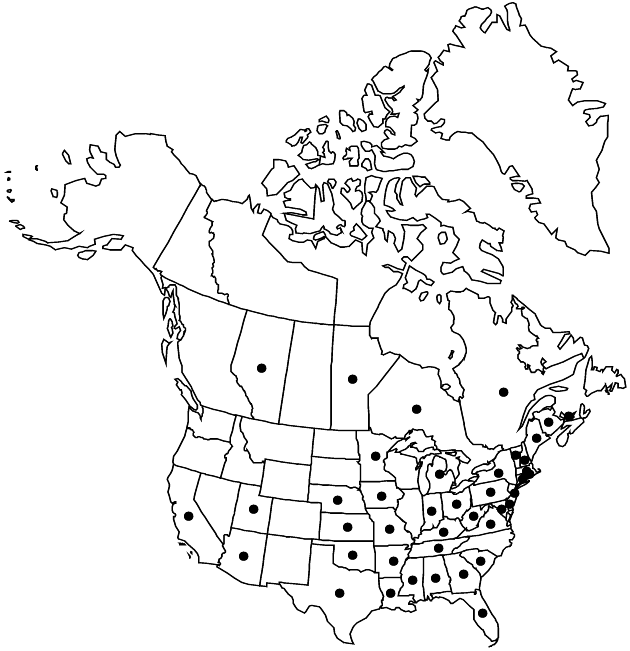Difference between revisions of "Solidago altissima subsp. altissima"
FNA>Volume Importer |
imported>Volume Importer |
||
| (6 intermediate revisions by 2 users not shown) | |||
| Line 1: | Line 1: | ||
{{Treatment/ID | {{Treatment/ID | ||
|accepted_name=Solidago altissima subsp. altissima | |accepted_name=Solidago altissima subsp. altissima | ||
| − | |accepted_authority= | + | |accepted_authority= |
|publications= | |publications= | ||
| + | |special_status={{Treatment/ID/Special_status | ||
| + | |code=E | ||
| + | |label=Endemic | ||
| + | }} | ||
|basionyms= | |basionyms= | ||
|synonyms={{Treatment/ID/Synonym | |synonyms={{Treatment/ID/Synonym | ||
|name=Solidago canadensis var. scabra | |name=Solidago canadensis var. scabra | ||
|authority=(Muhlenberg ex Willdenow) Torrey & A. Gray | |authority=(Muhlenberg ex Willdenow) Torrey & A. Gray | ||
| − | }}{{Treatment/ID/Synonym | + | |rank=variety |
| + | }} {{Treatment/ID/Synonym | ||
|name=Solidago scabra | |name=Solidago scabra | ||
|authority=Muhlenberg ex Willdenow | |authority=Muhlenberg ex Willdenow | ||
| + | |rank=species | ||
}} | }} | ||
|hierarchy=Asteraceae;Asteraceae tribe Astereae;Solidago;Solidago sect. Solidago;Solidago subsect. Triplinerviae;Solidago altissima;Solidago altissima subsp. altissima | |hierarchy=Asteraceae;Asteraceae tribe Astereae;Solidago;Solidago sect. Solidago;Solidago subsect. Triplinerviae;Solidago altissima;Solidago altissima subsp. altissima | ||
| Line 25: | Line 31: | ||
|elevation=0–1000+ m | |elevation=0–1000+ m | ||
|distribution=Man.;N.B.;N.S.;Ont.;P.E.I.;Que.;Sask.;Ala.;Ariz.;Ark.;Calif.;Conn.;Del.;Fla.;Ga.;Ind.;Iowa;Kans.;Ky.;La.;Maine;Md.;Mass.;Mich.;Minn.;Miss.;Mo.;Nebr.;N.H.;N.J.;N.Y.;Ohio;Okla.;Pa.;R.I.;S.C.;Tenn.;Tex.;Utah;Vt.;Va.;W.Va.;Mexico. | |distribution=Man.;N.B.;N.S.;Ont.;P.E.I.;Que.;Sask.;Ala.;Ariz.;Ark.;Calif.;Conn.;Del.;Fla.;Ga.;Ind.;Iowa;Kans.;Ky.;La.;Maine;Md.;Mass.;Mich.;Minn.;Miss.;Mo.;Nebr.;N.H.;N.J.;N.Y.;Ohio;Okla.;Pa.;R.I.;S.C.;Tenn.;Tex.;Utah;Vt.;Va.;W.Va.;Mexico. | ||
| − | |discussion=<p>Subspecies altissima is an escaped cultivar or has been introduced in Arizona, California, and Utah, and very likely in other western states. It is the most common and “weedy” member of subsect. Triplinerviae and has been introduced in many parts of the world. It replaces subsp. gilvocanescens in the eastern United States and adjacent Canada. Tetraploids are infrequent along the western edge of the subspecies’s distribution and rarely on glades in the southeastern United States. Hexaploids occur throughout the range. Array shape varies, narrower and elongate ones occurring in the southeastern United States; in Texas, such plants might be confused with Solidago juliae, which has more linear leaves. Further work is needed to analyze regional variants within each subspecies.</p> | + | |discussion=<p>Subspecies altissima is an escaped cultivar or has been introduced in Arizona, California, and Utah, and very likely in other western states. It is the most common and “weedy” member of subsect. Triplinerviae and has been introduced in many parts of the world. It replaces <i></i>subsp.<i> gilvocanescens</i> in the eastern United States and adjacent Canada. Tetraploids are infrequent along the western edge of the subspecies’s distribution and rarely on glades in the southeastern United States. Hexaploids occur throughout the range. Array shape varies, narrower and elongate ones occurring in the southeastern United States; in Texas, such plants might be confused with <i>Solidago juliae</i>, which has more linear leaves. Further work is needed to analyze regional variants within each subspecies.</p> |
|tables= | |tables= | ||
|references= | |references= | ||
| Line 34: | Line 40: | ||
-->{{#Taxon: | -->{{#Taxon: | ||
name=Solidago altissima subsp. altissima | name=Solidago altissima subsp. altissima | ||
| − | + | |authority= | |
| − | |authority= | ||
|rank=subspecies | |rank=subspecies | ||
|parent rank=species | |parent rank=species | ||
| Line 48: | Line 53: | ||
|publication title= | |publication title= | ||
|publication year= | |publication year= | ||
| − | |special status= | + | |special status=Endemic |
| − | |source xml=https:// | + | |source xml=https://bitbucket.org/aafc-mbb/fna-data-curation/src/2e0870ddd59836b60bcf96646a41e87ea5a5943a/coarse_grained_fna_xml/V19-20-21/V20_329.xml |
|tribe=Asteraceae tribe Astereae | |tribe=Asteraceae tribe Astereae | ||
|genus=Solidago | |genus=Solidago | ||
Latest revision as of 20:02, 5 November 2020
Involucres usually 3–4 mm. 2n = 36, 54.
Phenology: Flowering Aug–Oct.
Habitat: Dry to moist soils, fields, roadsides, disturbed areas
Elevation: 0–1000+ m
Distribution

Man., N.B., N.S., Ont., P.E.I., Que., Sask., Ala., Ariz., Ark., Calif., Conn., Del., Fla., Ga., Ind., Iowa, Kans., Ky., La., Maine, Md., Mass., Mich., Minn., Miss., Mo., Nebr., N.H., N.J., N.Y., Ohio, Okla., Pa., R.I., S.C., Tenn., Tex., Utah, Vt., Va., W.Va., Mexico.
Discussion
Subspecies altissima is an escaped cultivar or has been introduced in Arizona, California, and Utah, and very likely in other western states. It is the most common and “weedy” member of subsect. Triplinerviae and has been introduced in many parts of the world. It replaces subsp. gilvocanescens in the eastern United States and adjacent Canada. Tetraploids are infrequent along the western edge of the subspecies’s distribution and rarely on glades in the southeastern United States. Hexaploids occur throughout the range. Array shape varies, narrower and elongate ones occurring in the southeastern United States; in Texas, such plants might be confused with Solidago juliae, which has more linear leaves. Further work is needed to analyze regional variants within each subspecies.
Selected References
None.